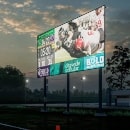How to Measure OOH Advertising Effectiveness: Metrics & KPIs
Outdoor advertising is also known as out-of-home (OOH) advertising. It is a powerful tool for reaching potential customers while on the go. Unlike online advertising, OOH advertising provides a physical presence. The physical presence can make a lasting impression.
Yet, measuring the effectiveness of OOH advertising campaigns can be difficult. It is possible to gauge the success of an OOH advertising campaign using the right KPIs. In this article, we will explore the different metrics, and KPIs used to measure the effectiveness of OOH advertising.
Key Metrics for Measuring OOH Advertising Effectiveness
Like everything, there are certain metrics for measuring ooh advertisement. Here are a few of them:
1. Reach and Frequency
Reach and frequency are two key metrics that can help measure the effectiveness of an OOH advertising campaign. Reach refers to the total number of people exposed to an outdoor advertisement. While frequency refers to the number of times, those people have seen the advertisement. By tracking these metrics, advertisers can determine how much their campaign reaches their target audience.
2. Impressions
Impressions refer to the number of times an advertisement has been viewed, regardless of whether the viewer is engaged with the ad. This metric can provide insight into the potential exposure of an OOH advertising campaign. Advertisers can use audience location measurement solutions to calculate impressions that track the number of people passing by the advertisement.
3. Viewability
Viewability is a metric that measures the visibility of an advertisement to the intended audience. In OOH advertising, viewability can be measured by the advertisement's placement and the audience's viewing distance. Outdoor Ads placed in high-traffic areas and visible from a distance are more likely to be viewed and can result in greater brand recognition.
4. Engagement
Metrics Engagement metrics refer to the number of interactions between viewers and the advertisement, such as scanning a QR code or visiting a website. While OOH advertising is not designed to elicit immediate engagement, it can drive brand recognition and increase the likelihood of future engagement.
5. Conversion
Metrics Conversion metrics refer to the number of viewers who take a desired action after seeing an advertisement, like purchasing or visiting a website. It can be challenging to track conversions in OOH advertising. But it is still possible to use metrics such as website visits or social media account engagement to measure the effectiveness.
KPIs for Measuring OOH Advertising Effectiveness
Key Performance Indicators (KPIs) are essential for evaluating any advertising campaign's success, including OOH advertising. Using KPIs, advertisers can track specific metrics and understand how well their campaign performs. In OOH advertising, KPIs focus on brand awareness, buy intent, foot traffic, and return on investment. In this section, we'll explore some of the most important KPIs for measuring the effectiveness of OOH advertising.
1. Brand Awareness and Recall
Brand awareness and recall refer to how well a viewer remembers an advertisement and its brand. KPIs for measuring brand awareness and recall can include surveys and focus groups that measure the degree to which viewers remember the advertisement and associate it with the brand. Advertisers can also track social media engagement, such as shares and likes, to measure brand awareness.
2. Purchase Intent
Buying intent refers to the likelihood that a viewer will purchase after seeing an advertisement. KPIs for measuring Buying intent can include surveys and website traffic data. It tracks the number of viewers visiting a website or purchasing after seeing an OOH advertisement.
3. Foot Traffic and Sales
Lift Foot traffic and sales lift refer to the increase in the number of people visiting a physical location or making a purchase after seeing an OOH advertisement. KPIs for measuring foot traffic and sales lift can include sales data and location-based analytics that track the number of visitors to a specific location before and after an OOH advertising campaign.
4. Share of Voice (SOV)
Share of Voice (SOV) refers to the percentage of advertising in a given market or industry owned by a specific brand or company. KPIs for measuring SOV can include surveys and data analysis that track the percentage of viewers who remember a specific advertisement or associate it with a particular brand.
5. Return on Advertising Spend (ROAS)
Return on Advertising Spend (ROAS) refers to the revenue generated for every dollar spent on advertising. KPIs for measuring ROAS can include sales data and website traffic analysis that tracks the revenue generated by an OOH advertising campaign compared to the amount spent.
6. Brand Favorability and Sentiment
Brand favorability and sentiment refer to the degree to which viewers perceive a brand after seeing an advertisement. KPIs for measuring brand favorability and sentiment can include surveys and social media analytics that track the number of positive and negative comments and reviews associated with a specific brand or campaign.
Measuring OOH Advertising Effectiveness Across Different Formats
OOH advertising can take many forms, from traditional billboards to digital screens in public spaces. As a result, measuring the effectiveness of OOH advertising can be challenging, as each format requires a different set of metrics and KPIs. In this section, we'll explore how to measure the effectiveness of OOH advertising across two different formats: traditional and digital.
Traditional OOH Advertising
Traditional OOH advertising includes billboards, transit ads, and other static displays that have been an industry staple for decades. Measuring the effectiveness of traditional OOH advertising involves reach and frequency metrics, impressions, and viewability. But, with new technology and audience location measurement solutions, advertisers can track foot traffic and sales lift more than ever. This data can be used to understand how traditional OOH advertising drives engagement and conversion.
Digital OOH Advertising
Digital OOH advertising refers to any OOH advertising that uses digital screens, such as LED displays and interactive kiosks. Measuring the effectiveness of digital OOH advertising requires a different set of metrics and KPIs than traditional OOH advertising. Besides reaching and frequency, impressions, and viewability, digital OOH advertising allows for engagement metrics such as click-through rates and dwell time.
These metrics can be used to understand how well the ad captures viewers' attention and drives them to act. Digital OOH advertising can also be linked to online advertising and social media accounts, allowing advertisers to track conversions and engagement across many channels.
Best Practices for Measuring OOH Advertising Effectiveness
Measuring the effectiveness of OOH advertising can be challenging, but by following best practices, advertisers can ensure they get the most out of their campaigns. This section will explore some best practices for measuring OOH advertising effectiveness.
1. Establish a Clear Objective
The first step in measuring OOH advertising effectiveness is to establish a clear aim for the campaign. This aim should be specific, measurable, and aligned with the brand's marketing goals. With a clear goal, it can be easier to determine which metrics and KPIs are most relevant to the campaign.
2. Select the Right Metrics and KPIs
Once the objective has been established, selecting the right metrics and KPIs to measure campaign performance is important. As we discussed earlier, different formats of OOH advertising need different metrics and KPIs. Advertisers should choose the metrics and KPIs most relevant to their campaign goal and format.
3. Use Data and Technology to Track Performance
To measure the effectiveness of OOH advertising, advertisers should use data and technology to track performance. This includes using audience location measurement solutions to track foot traffic and sales lift and implementing cross-channel tracking to understand how OOH advertising impacts online and social media engagement.
4. Benchmark Performance Against Competitors
Benchmarking campaign performance against competitors can provide valuable insights into how well a campaign performs relative to others in the industry. Advertisers can use this information to make informed decisions about optimizing their campaigns for maximum impact.
5. Create Customized Metrics
Sometimes, standard metrics and KPIs may only capture the effectiveness of a specific OOH advertising campaign. Advertisers should consider creating customized metrics tailored to the specific campaign aim and format in these cases.
6. Utilize Geo-Location
Data can provide valuable insights into the audience demographics and behaviors of those exposed to OOH advertising. Advertisers can use this information to understand their target audience better and optimize their campaigns.
7. Implement Cross-Channel Tracking
Finally, cross-channel tracking can provide a more comprehensive understanding of how OOH advertising impacts marketing performance. Advertisers can better understand how OOH advertising fits into the larger marketing mix by tracking engagement and conversion across many channels.
By following these best practices for measuring OOH advertising effectiveness, advertisers can make informed decisions about optimizing their campaigns for maximum impact.
Challenges in Measuring OOH Advertising Effectiveness
While measuring the effectiveness of OOH advertising campaigns is essential for optimizing and improving their performance, there are several challenges that advertisers need to overcome. These challenges include:
1. Attribution and Causation
One of the most significant challenges in measuring OOH advertising effectiveness is attribution and causation. Unlike other forms of advertising, it can be challenging to attribute a sale or conversion to a specific OOH ad. This is because OOH ads often work with other marketing channels, such as online and TV ads. As a result, it can be difficult to determine the exact impact of OOH ads on a consumer's buying decision.
2. Limited Tracking Capabilities
Another challenge in measuring OOH advertising effectiveness is the limited tracking capabilities of traditional OOH ads. Unlike online ads, which can be tracked using cookies and pixels, tracking the number of people who see a particular outdoor ad can be challenging. It can be challenging to track the impact of OOH ads on consumer behavior, such as foot traffic to a store or website visits.
3. Seasonality and External Factors
Finally, seasonality and external factors can also present challenges when measuring OOH advertising effectiveness. For example, certain OOH ads may perform better during certain times of the year or in certain weather conditions. External factors such as changes in the economy or consumer behavior can also impact the effectiveness of OOH ads. As a result, advertisers need to be aware of these challenges when measuring the effectiveness of their OOH advertising campaigns.
The Future of OOH Advertising Effectiveness Measurement
As technology advances, so will the methods used to measure the effectiveness of OOH advertising campaigns. Here are two trends that are likely to shape the future of OOH advertising effectiveness measurement:
The Potential of Artificial Intelligence
Artificial intelligence (AI) has the potential to revolutionize the way that OOH advertising effectiveness is measured. With AI-powered analytics tools, advertisers can gain deeper insights into the performance of their OOH ads, including how people interact with them and how they impact consumer behavior. By analyzing data from various sources, such as social media accounts and audience location measurement solutions, AI can help advertisers optimize their OOH ad campaigns and improve their ROI.
The Rise of Integrated Campaign Measurement
As more advertisers move towards integrated marketing campaigns that span many channels, measuring the effectiveness of individual channels, including OOH advertising, will become important. Integrated campaign measurement involves looking at the impact of each channel on the campaign performance.
This approach allows advertisers to understand better how their OOH ads perform in other marketing channels, such as digital ads. By measuring the effectiveness of their OOH ads as part of an integrated campaign, advertisers can optimize their advertising spend and improve their ROI.
Ultravision LED Solutions: Turnkey Digital OOH Advertising Solutions
For businesses and advertisers looking to take their OOH advertising campaigns to the next level, Ultravision LED Solutions offers state-of-the-art LED video walls that can help impact audiences. With our turnkey digital OOH advertising solutions, we provide businesses and advertisers with everything they need to create eye-catching and engaging campaigns that capture attention and drive results.
Our solutions are ideal for various applications, from large-scale billboards to smaller digital displays in retail environments. With our unique LED technology and digital signage expertise, Ultravision LED Solutions can help you design and deploy campaigns that target your desired audiences.
Whether you're looking to measure the effectiveness of your outdoor ad campaign or starting to explore the possibilities of an OOH campaign, Ultravision LED Solutions can help. To discover our full range of LED video walls and digital signage solutions, and learn how we can help take your OOH advertising to the next level, visit the following page: https://ultravisionledsolutions.com/collections/main
FAQs
What is outdoor advertising, and why is it important?
Outdoor advertising, also known as out-of-home media, is any advertising that reaches consumers outside their homes. This can include billboards, transit ads, and street furniture ads. Outdoor advertising is important because it allows advertisers to reach a large and diverse audience in a public space, often at a lower cost than traditional forms of advertising.
How can I measure outdoor advertising campaigns?
Measuring the effectiveness of an outdoor advertising campaign can be challenging, but several metrics can be used to gauge success. These include reach and frequency, impressions, viewability, engagement metrics, conversion metrics, brand awareness and recall, buy intent, foot traffic, sales lift, and return on advertising spend (ROAS). By tracking these metrics, advertisers can gain insights into the impact of their campaigns and make data-driven decisions to optimize performance.
What are the benefits of using a billboard ad in an outdoor campaign?
Billboard ads are a popular and effective form of outdoor advertising. They offer high visibility and can be placed to reach a targeted audience. Billboard ads are also cost-effective, especially compared to other advertising forms such as TV or radio. Billboard ads are often memorable. They can help build brand recognition and increase consumer awareness.










